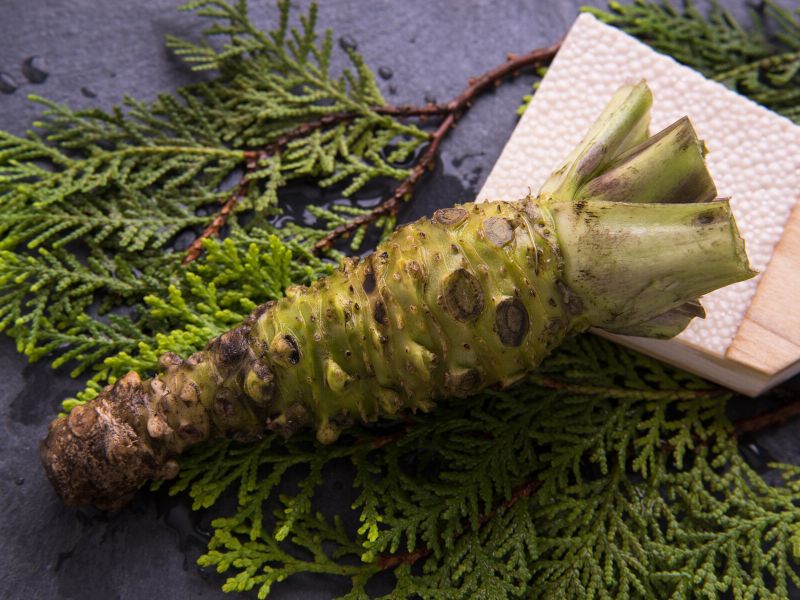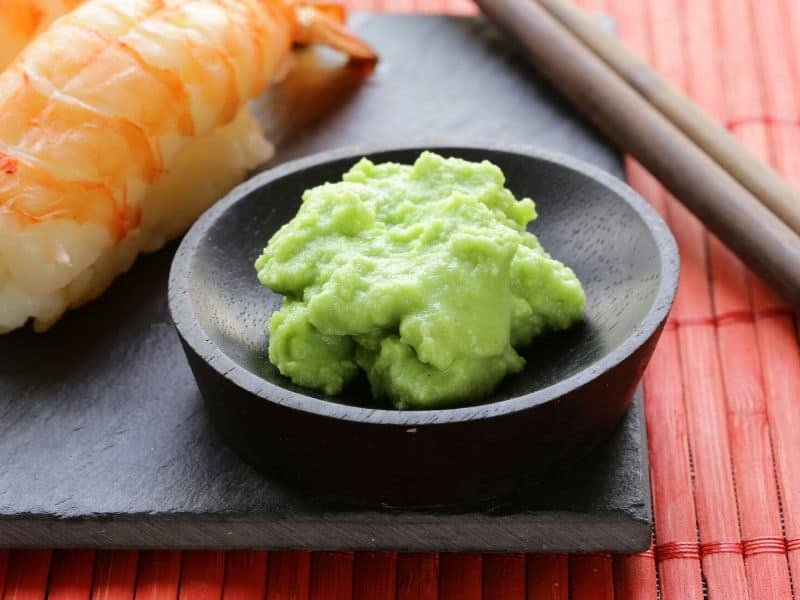Real wasabi is made from the root of the Wasabia japonica plant, also called Japanese horseradish. In comparison, the fake one is made of horseradish, mustard, cornstarch, and green colorant.

And why does it have that distinctive flavor? In this blog post, we will answer your questions about this Japanese mustard!
What is Wasabi?
It is a horseradish type commonly used as a condiment in Japanese cuisine.
You can find them at most Japanese restaurants. And they are specially served with sushi or other Japanese dishes.
The green paste has a strong, pungent flavor that is often described as “spicy” or “hot.” However, unlike chili peppers, the heat from Japanese does not linger on your tongue.
What is Wasabi Made of?

What is real wasabi made of?
The answer is simple. Real wasabi, or authentic wasabi, is made from the root of the Wasabia japonica plant, also called Japanese horseradish, a plant of the mustard family (Brassicaceae).
This plant grows naturally in mountain streams in Japan and has been cultivated on a farm for centuries. Its cultivation is limited because of its specific growing requirements.
The fresh root is harvested and then grated into a paste. This natural paste can be used fresh, or it can be dried and powdered.
The powder is mixed with water to create the familiar green condiment we know and love.
What is fake wasabi made of?
Most wasabi paste is fake! It is made of horseradish, mustard, cornstarch, and green food coloring.
Sometimes, mustard is added to the mixture, and very occasionally, a tiny amount of real grated wasabi or dried powder.
It has a flavor similar to the real but lacks the characteristic pungency and “heat.”
So, if you’ve ever eaten sushi and thought the wasabi was bland or tasteless, you were eating a fake one!
How can you tell if wasabi is real?

When it becomes pasty and thick, it’s a sure sign that it’s manufactured from horseradish (pureed to give a completely smooth texture).
If the texture is gritty (freshly grated by a ceramic grater), it’s more likely to be genuine from a fresh rhizome or plant stem.
Additionally, real wasabi paste will lose its flavor quickly when exposed to air, so it is probably fake if the paste you use does not have a strong flavor.
Move on if the ingredients list has anything besides wasabi or Wasabia japonica.
What Does Wasabi Taste Like?

Why is wasabi so spicy?
The heat comes from the compound allyl isothiocyanate, also found in mustard and horseradish.
When you eat it, this compound binds to the receptors in your nose responsible for detecting spicy flavors. This triggers a reaction in your brain that makes you feel like you are “breathing fire!”
The flavor is also described as being sharp, pungent, and earthy. Some say it tastes slightly sweet, while others find it bitter.
Regardless of its exact flavor, there’s no doubt that it packs a powerful punch!
Is wasabi bitter or spicy?
The answer is both! The heat from the allyl isothiocyanate compound can be intense but dissipates quickly.
Some people also taste a slight bitterness from the glucosinolates in the plant’s roots.
Does real wasabi taste like horseradish?
No, the real one does not taste like horseradish. As we mentioned earlier, horseradish is one of the ingredients in fake.
While horseradish and wasabi share a similar pungent flavor, they are not identical. The European horseradish is hotter and fierier, while the authentic one has a sharper, more complex flavor.
Is Wasabi Good for Health?

Benefits
It is a good source of fiber, calcium, and potassium. It also contains vitamins C and E, as well as beta-carotene.
Some studies have shown that it has antioxidant and anti-inflammatory effects. Additionally, the compounds may help boost immunity and protect against specific cancerous cells.
So, not only does it add flavor to your food, but it may also be good for your health!
What happens if you eat a spoonful of wasabi?
Be prepared for an intense burning sensation if you’re brave enough to eat a spoonful!
The heat can be overwhelming, so it’s best to start with a small amount and gradually increase the amount you eat.
Overeating it at once can cause watering eyes, runny nose, and even temporary blindness. So, proceed with caution!
What does wasabi do to your brain?
When you eat it, the allyl isothiocyanate compound binds to the receptors in your nose responsible for detecting spicy flavors.
This triggers a reaction in your brain, which response by causing the body to sting, burn, itch, cough, choke, or drip tears. And that makes you feel like you are “breathing fire!”
The heat can be intense, but it dissipates quickly.
Can wasabi help you lose weight?
Some say it can help you lose weight, but no scientific evidence supports this claim.
While it does contain compounds that may have some health benefits, there is no evidence that it can help you lose weight.
So, if you’re looking to shed some pounds, you’ll need to find a different method!
Wasabi and Sushi

Why is wasabi used in sushi?
Wasabi is used in sushi because it pairs well with the flavor of raw fish. Its sharp, pungent flavor helps offset the fishy taste of sushi.
Additionally, it has antibacterial properties. The heat can help to kill any bacteria that may be present in the raw fish.
Specifically, “6-methyl sulfinyl hexyl isothiocyanate” has been identified as an anti-microbial agent effective against bacteria such as E. coli and Staphylococcus aureus.
For these reasons, it is an essential ingredient in sushi!
How much wasabi should you use?
The amount you use is up to you!
Some people like to add a lot to their sushi, while others prefer just a tiny amount. It all depends on your personal preference.
If unsure how much to use, start with a small amount and gradually add more until you find the perfect balance for your taste buds!
How do you eat wasabi with sushi?
Traditionally, sushi is eaten with your hands.
First, take the sushi rolls in your hand and dip them into soy sauce. Then, mix a small amount of wasabi into the soy sauce.
Finally, eat the sushi! The wasabi will be outside the sushi, so you can control how much you eat.
Of course, you can also use chopsticks to eat your sushi. If you do, dip the sushi in soy sauce before adding it.
How to Use Wasabi
Now that we know all about it let’s discuss how to use it!
It can be used in various ways as a condiment and an ingredient in Japanese food recipes.
Here are some ideas:
- Serve the paste with soy sauce as an accompaniment for sushi and sashimi.
- Add it to soy sauce to create a spicy dipping sauce for tempura.
- Make mayonnaise by mixing the paste with store-bought or homemade mayonnaise.
- Use it as a sandwich spread or add it to deviled eggs.
- Stir the paste into miso soup or use it as a topping for soba noodles.
- Make a spicy vinaigrette by mixing the paste with rice vinegar, vegetable oil, honey, and soy sauce.
- Use it to spice up grilled meats or vegetables.
- Add it to a Bloody Mary or other savory cocktails.
We hope you enjoyed learning! Now go out and enjoy this delicious condiment in all its forms!
FAQs
Is wasabi horseradish?
According to a new video from the American Chemical Society, the vast majority consumed in the United States is a combination of horseradish, hot mustard, and green food colorant.
In reality, about 99% of all wasabi sold in the US is fake, according to The Washington Post.
Which is hotter, wasabi or horseradish?
Horseradish is hotter, but the heat from horseradish dissipates quickly. The fresh wasabi paste has a more prolonged heat that can be intense but dissipates quickly.
Can you grow wasabi in America?
Yes, you can grow it in America. The plant grows best in shady, moist conditions with temperatures between 60 and 70 degrees Fahrenheit.
While the plants are native to Japan, they can also be found in North America, Europe, and Australia.
Related Topics
What’s the Spiciest Thing in the World?
There is no definitive answer to this question since it depends on personal taste.
However, the Carolina Reaper pepper is one spicy food that will set your taste buds on fire. This pepper is the world’s hottest chili pepper and has a Scoville heat rating of more than 2,200,000 units!
So if you’re looking for a spicy challenge, give the Carolina Reaper a try.
How Expensive is Real Wasabi?
It can be pretty expensive since real it is a difficult crop to cultivate. It takes almost two years for the plants to mature, and the rhizomes (the edible part) only grow for a few weeks each year.
Plus, real wasabi is more labor-intensive to harvest than other types of horseradish. All that means that the real one is usually more expensive than imitation stuff.
Why Is Wasabi So Spicy?
It is so spicy because it contains a chemical called allyl isothiocyanate. This compound is responsible for the burning sensation you feel in your mouth.
Allyl isothiocyanate works by irritating your nasal passages and lungs. When it comes into contact with these tissues, it causes them to swell up and produce mucus.
This, in turn, leads to the stinging sensation that you experience.
Is Wasabi Good for Your Stomach?
Yes. There is some evidence that it may help with stomach problems.
Some people believe that the antibacterial and anti-inflammatory properties may help to calm down an upset stomach or reduce inflammation in the digestive tract.
However, consuming too much may cause acid reflux, diarrhea, or nausea in some individuals.
What are the Ingredients in Wasabi?
The real one is made from the root of the Wasabia japonica plant. The plant is a member of the cabbage family and grows in cold climates. The root is grated into a paste, then used as a condiment.
Is Wasabi Good for Dogs?
It is not suitable for dogs to eat, but it is not toxic.
This Japanese horseradish is an incredibly spicy root. So, your dog may have gastrointestinal upset if they consume it.
